 |
||
|
||
| ||
the First Mobile Hard Drive to Conquer 50 MB/s
We carry on reviewing modern 2.5" hard drives for Medium- and High-End notebooks. We already reviewed the first series of mobile 7K drives from Seagate — Momentus 7200.1. Now it's high time to have a look at similar drives from the competitor, that is at the second series of mobile 7K drives from Hitachi — Travelstar 7K100. 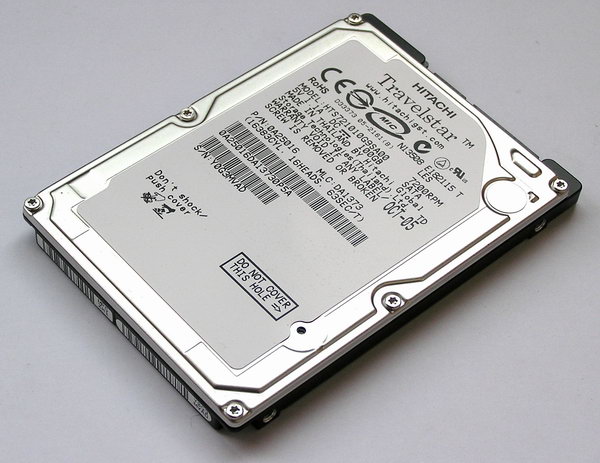 Hitachi Travelstar 7K100 100 GB drive
Having appeared on the market at the same time as Momentus 7200.1, the 7K100 drives inherited and developed the nearly 2-year Hitachi traditions of manufacturing hard drives of this class, that started from Travelstar 7K60. They also inherited their codename: the 7K60 model was called Moraga-C, and the 7K100 got the name Moraga Plus C. Travelstar 7K100 drives are the only mobile 7K drives of the second generation on the market so far. However, Seagate has recently announced Momentus 7200.2. When they actually appear on the market, the 7K100 model will be no more unique. :) 2.5" mobile drives with the spindle rotational speed of 7200rpm were initially designed to raise HDD performance in notebooks to the desktop level. But this situation has been full of conventions up to now, as the maximum linear read rate in desktop 7K drives has reached 60 MB/s several years ago (50MB were outstepped long ago). And the first mobile 7K drives could boast only of 40MB/s odd. And the average access time in these mobile drives (about 15ms) couldn't compare with typical 13ms for desktop 7K drives, despite a noticeably shorter linear travel and weight of the actuator arm with heads (however, hardly lower angular travel, but smaller surface area/power of VCM magnets). Nevertheless, we can only welcome the fact that manufacturers strive to reach the desktop performance level in their notebook drives. Perhaps, the first real applicant to the conquering role will be the top model in the Hitachi Travelstar 7K100 series. For the first time in the history of 2.5" drives for notebooks (as the magnificent Savvio 10K.1 is of the different size) it managed to outstep 50MB/s for maximum linear transfer rate. So it comes close to its desktop counterparts.
Travelstar 7K100: Design and CharacteristicsHard drives from this series have become the second 2.5" drives after Hitachi Travelstar 7K60 from this manufacturer with the spindle rotational speed of 7200rpm. The key technical characteristics of these drives in comparison with predecessors and competitors are published in Table 1. You can compare their characteristics with those of some mobile 5K and 4K drives in this summary table. Table 1. Key properties of 7200rpm notebook drives from Hitachi and Seagate
First of all, while top 100GB Travelstar 7K100 series models offer the data density of 81 Gbit per square inch, cheaper models from this series (80GB and 60GB) offer lesser data density — 66 Gbit per square inch. For your comparison, the data density of Hitachi Travelstar 7K60 drives is 50 Gbit per square inch versus 81 Gbit per square inch in Seagate Momentus 7200.1. It's much less than in most modern mobile 5K drives (about 100 Gbit per square inch and even greater in PRM series). By the way, data density in 7K100-series drives is a tad lower than in their "near-counterparts" with lower rotational speed - Hitachi Travelstar 5K100 drives, which maximum capacity also reaches 100GB (their data density amounts to 86 and 70 Gbit per square inch for the top model and for the other models correspondingly). Like Momentus 7200.1, all Hitachi 7K100 series drives are equipped with 8MB buffers and use 50GB or 40GB platters. But the maximal linear density of up to 768 000 BPI with the track density of 127 000 TPI in the 7K100 is evidently higher than in Momentus 7200.1. Note that the minimal gap between tracks in the 7K100 is about 200nm, while the surface area of a single bit along a track is just 33nm (just like the effective gate length in modern 65nm transistors in Intel processors). As 80GB and 60GB 7K100 models have noticeably lower data density than the 100GB model, their linear platter access rate is noticeably lower than in the specs. So if you want maximum rates, you should pay attention only to the top two (that is 100GB) models from this series. In other respects, the 7K100 characteristics differ noticeably from those of the 7K60 as well. For example, the maximum internal linear read rate has grown by more than 20% (from 518 Mbit/s to 629 Mbit/s). However, considering that these drives still use adaptive formatting, your sample may demonstrate slightly different results. Operating shock resistance of the 7K models from Hitachi got significantly better (from 200G to 300G). Together with 1000 G for non-operating shock resistance, it makes them the most reliable mobile hard drives among 7K models. Compared to the 7K60, operating acoustics also got a tad better (especially in seek mode) as well as power consumption / heat dissipation (the latter can even compare with that of 5K models). Of course, the model range of hard drives got bigger, top models got greater capacities. There also appeared models with Serial ATA interface (only 1.5 Gbit/s so far, but with NCQ support). The average seek time hasn't changed formally (compared to 7K60), as well as operating and non-operating temperatures.  However, Hitachi asserts that its drives can operate well at +60° and even higher (with lower MTBF). By the way, the guaranteed number of Load/Unload cycles for the 7K100 has been doubled (versus 7K60) to 600 thousands that can compare with professional SCSI/SAS drives. This value is much higher than in desktop ATA drives! Of course, these drives also use Ramp Load/Unload Technology. As well as TrueTrack Technology and FDB motor.  Insides of Hitachi Travelstar 7K100.
Like in the 7K60, it uses so-called femto-sliders (read the details here and here), that were initially introduced into the 7K60. Among rather new and interesting technologies we should mention PRML (Partial Response Maximum Likelihood) and two power management technologies: HiVERT and Enhanced ABLE. The first one stands for Hitachi Voltage Efficiency Regulator Technology. Together with Enhanced ABLE, it allows to reduce power consumption without performance penalties. That's how it works. If the +5V line powers only the spindle and VCM motors of a mobile drive, as well as the chip with preamplifiers, the other electronics of the drive may be powered from the lower-voltage lines (for example, +3.3V and +1.5V). While older solutions incorporated simple cascaded linear regulators to get lower voltages from 5V (which required much power, the left diagram), HiVERT allows to replace some of them with more economic switching voltage regulators, which conversion efficiency amounts to 90% (the right diagram). 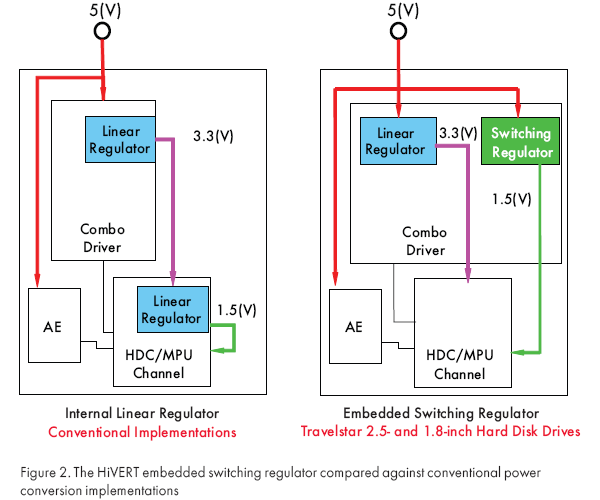 This solution was used for the first time in Hitachi Travelstar 5K100 drives, where the switching regulator reduced the voltage from 5V to 3.3V. A linear regulator, integrated into the central processor of a hard drive (HDC/MPU), was used to reduce 3.3V to 1.5V. Later modifications of the second-gen HiVERT (for example, for Travelstar 4K120 and 7K100) also use a switching regulator to reduce +5V to +1.5V. According to Hitachi research, these measures allow to reduce the operating temperature of a hard drive by 3°-5°. As is well known, a 10° drop in temperature doubles the service life of a hard drive. That is HiVERT can prolong the life of Hitachi drives by approximately 50% (depending on some other conditions). What concerns Enhanced ABLE 3.0 (Adaptive Battery Life Extender), which is used in Hitachi Travelstar 4K80, 5K80, 7K60, 5K100, 7K100, Microdrive 3K6, and some other series (the first generation of ABLE appeared back in 1995), this technology uses extended modes to reduce power consumption during operation and when idle. Such as Performance Idle, Active Idle, Low Power Idle, Adaptive Standby Mode in addition to standard Sleep Mode, Standby Mode, Idle Mode, and Active Mode, which are set through Advanced Power Management (read the details at the link above). However, Hitachi is not the only company to use switching voltage regulators in mobile disk controllers, they can be seen in models from other manufacturers of late (read, for example, our recent reviews of such drives). Like the 7K60, the 7K100 dimensions are 100x70x9.5mm, 115g. Travelstar 7K100 drives do not differ much from the old 7K60 in exterior: 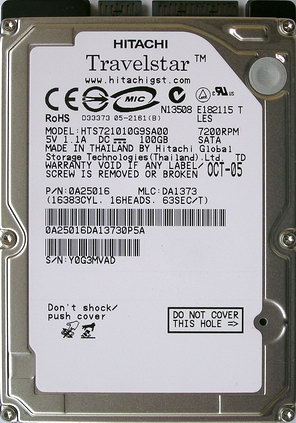  They use a similar case (hermetic unit). 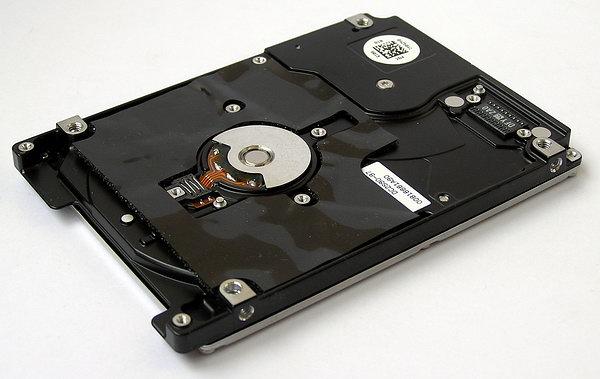 Controller boards of the 7K100 drives with UltraATA/100 and Serial ATA interfaces have similar layouts, though some elements are different.  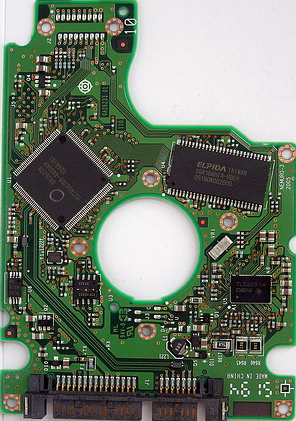 By the way, nearly the same processors were used in the corresponding 5K100-series models. Here is the switching voltage regulator, we mentioned above:  From the point of view of supported functions, the differences between 7K100-series models with different interfaces come down to the lack of Interface Power Management and NCQ support in UltraATA modifications. Seek acoustics management via the AAM register is certainly supported here. 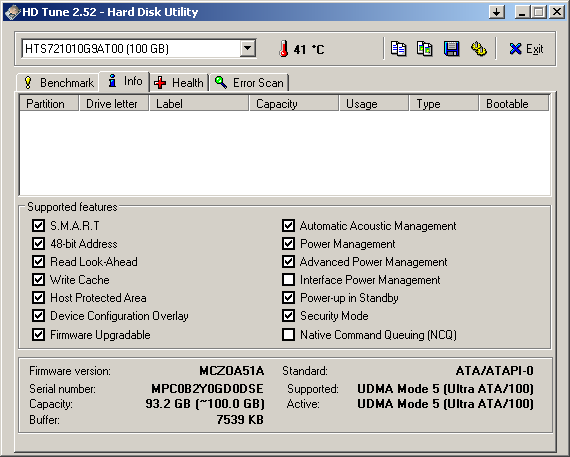
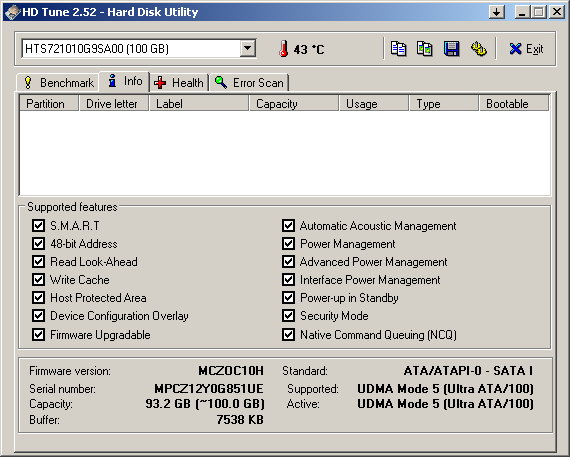 Travelstar 7K100 drives are designed not only for high-performance notebooks, game boxes, and compact desktop systems. They can also be used in video edit systems, graphics and CAD stations, or even in entry-level compact servers. By the way, not long ago (in mid June 2006), Travelstar 7K100 drives (and other Hitachi GST mobile storage drives) got the RoHS certificate.
Test participantsLet's proceed to tests. Following our good old tradition (adaptive formatting leads to different performance results of different samples of the same model) we tested the top model with parallel interface HTS721010G9AT00, as well as two "identical" drives - HTS721010G9SA00 100GB with Serial ATA interface. The following models took part in our tests:
You can compare performance results of our contenders with older hard drives on your own - just use the data from our previous reviews, as they used the same test procedure.
Performance Test ProcedureWe used the following testbed configuration to test 2.5" drives:
The mobile drives are mounted firmly on the metal racks of a testbed chassis and connected via an adapter to the UltraATA/100 controller or directly to the Serial ATA controller on the ICH5 bridge. The main hard disk was installed as master on the first channel of the chipset controller, and a hard disk to be tested was installed as master on the second channel of the same controller. The tests were carried out under MS Windows XP Professional SP1. The hard disks were tested not partitioned (in Intel Iometer, H2Benchw and AIDA32 tests) as well as partitioned and formatted by regular operating system tools depending on a test type: one NTFS partition of maximum size for testing the average access time and plotting the read speed graph in WinBench 99 and two NTFS or FAT32 partitions of the same size for other tests (WinBench Disk WinMark 99, copying files with various patterns, ATTO Disk Benchmark test, multithreaded read/write Nbench 2.4 test and the hard disk speed test in Adobe Photoshop). Each NTFS partition occupied half of the entire disk capacity (that is the second partition started exactly from the second half of the disk). FAT32 partitions were 32768MB, the first one starting at the outer edge of the media (on the "fastest" tracks), and the second — exactly from the second half of the media volume. NTFS and FAT32 cluster sizes were selected by default — 4 and 16 KB correspondingly. We used AIDA32, H2benchw, and WinBench 99 tests to find out physical characteristics of drives (average access time, interface transfer rates, and linear disk transfer rates). To estimate the overall performance we use multiple patterns from Intel Iometer, a good test C'T H2Benchw, Adobe Photoshop swapping performance, multithreaded read/write, and the generally recognized WinBench 99.
Baseline Test ResultsFirst of all, we are going to publish linear reading graphs (click on them to see full-size diagrams). To compare them with graphs for other mobile drives, you may open the page with our last year's roundup.
As we already noted in our Travelstar 5K100 review, adaptive formatting in the new generation of these Hitachi products is not gone despite the seeming smoothness of linear transfer graphs demonstrated by these Hitachi drives in popular benchmarks, unlike the graphs of Hitachi 7K60 and 5K80. You can see it well on the large-scale graphs.  Interestingly, adaptive formatting actually uses just three density/speed levels in all the three 7K100 drives we tested (at least in the beginning of the disk). But these levels differ from each other by up to 14%! Even the lowest level corresponds to the linear read rate of 50 MB/s in the beginning of the disk. We can also see that the average performance results (graphs) are similar for all the three models. That is there is no great difference in linear transfer rates between the same models, as in Seagate Momentus 7200.1. In particular, both SATA models of the 7K100 series demonstrated similar results in all the tests. So we are going to publish results of only one of them. Hitachi 7K100 100GB drives expectedly leave all their predecessors and competitors far behind in the linear read rate, having demonstrated the average transfer rate at the outer tracks on the level of 53 MB/s. Hitachi drives show expectable UltraATA/100 and Serial ATA transfer rates: it's on a good level, though it might have been higher in the SATA models, considering the results of competing drives. The average disk access time in the models under review is on the level of 15 ms, which is a tad worse than in the 7K60. But on the whole, it's no worse than in Seagate M7200.1. In quiet seek mode, the disk access rate generally slows down just by 0.5 ms, which is hardly a slow-down. Performance of our drives may not even suffer from the quiet seek mode. What concerns the average disk write access time, which in this case reflects the efficiency of caching data for random writing in an HDD buffer, there are no surprises. The new 7K drives from Hitachi demonstrate excellent results, even record-breaking for 2.5" drives.
Performance in applicationsAlas, Hitachi 7K100 drives do not break any records in multithreaded write tests, being outperformed by drives from Seagate, Samsung, and even Hitachi 7K60. That seems to be the fault of insufficient firmware optimization of these controllers for such tasks. However, these results are not a failure either, as the 7K100 is faster in these tests than many other 2.5" hard drives. On the other hand, our contenders look good in the multithreaded read test: having been outperformed only by the well-optimized 5K models from Fujitsu and Samsung M60 as well as by the new drive Hitachi 5K160, the latest 7K models from Hitachi evidently improved their results compared to 5K100 and 7K60. They have outscored many competitors, including Seagate M7200.1. The detailed multi-threaded write test shows that 7K100 performance does not drop much, even when 4 write threads are spaced out between the start and the middle (in terms of capacity) of a hard drive. The situation in Disk WinMark 99 tests from the WinBench 99 package is generally in favor of the latest 7K Hitachi drives, if we don't take into account 160GB models. However, Hitachi 7K100 drives are actually outperformed by 7K drives from Seagate in the NTFS Business test. In return, Hitachi 7K100 drives are beyond competition in the High-End test, quiet seek mode does not spoil the picture. Hard drive performance in a typical personal computer mode is also estimated with two complex track tests — Futuremark PCmark 04 and C'T H2benchW. Hitachi 7K100 is leading in the first test, quiet seek is even better than the regular mode, and the SATA model is outperformed by the PATA model only by a couple percents. Our contenders break away from the competitors in another similar test H2benchW, where they indeed reach the typical performance level of desktop hard drives (even if this level is from the recent past). Adobe Photoshop Swapping Performance test demonstrates even more reassuring results: we can again see that Hitachi Travelstar 7K100 is beyond competition among 2.5" hard drives, having outperformed the nearest competitors by more than 10%. The quiet seek mode is no problem.
Intel Iometer testsAs the manufacturer positions these drives for entry-level compact servers as well, their performance results in various server and workstation IOmeter patterns are very important. There will certainly be many users who will use the 7K100 drives in compact servers (I have even seen ready systems). Let's start with mean results of traditional File Server, Web Server and Database patterns. Alas, results of all the three samples of the 7K100 drive are disappointing: our contenders are outperformed by their predecessor 7K60 and Seagate M7200.1. Though they are still faster than mobile 5K drives, this is hardly consoling. Workstation pattern demonstrates the same picture. That seems to be the fault of firmware in the new drives, as the recently launched Hitachi 5K160 drives demonstrate slack results in these server tests as well (though it's pardonable to the latter drives). What concerns more personal tasks, such as reading, writing, and copying large and small files (we evaluate performance here with our own random access patterns), the 7K models from Hitachi rule unconditionally here. They get back the title of the fastest hard drives for notebooks. However, the old Travelstar 7K60 also behaved like a brick! Interestingly, Hitachi 7K100 drives lead in nearly all separate operations (reading, writing, and copying large and small files), standing up to their "star" status. Our contenders outperform all their competitors in the NTFS defragmentation test, but they are slightly outperformed by Seagate M7200.1 drives in case of FAT32. So, all mobile 7K drives are generally on a par here. And finally, Travelstar 7K100 drives again flex their muscles in streaming read/write patterns with large or small blocks (they imitate a digital recorder with the timeshifting function or a video editing load on a drive), having outperformed all models (except for 5K drives from Fujitsu) with large blocks and nearly all drives (but Hitachi 5K160 and Samsung M60) with small blocks.
Power Consumption and Heat DissipationThe manufacturer notes low power consumption of these 7K drives in the specifications that can compare with the 5K level. We'll find out whether it's true. But judging from the specifications, we shouldn't expect miracles. Following the streamlined test procedure (see, for example, here and here), we measured the typical current drain of these drives in various operation modes: idle, read, write, active seek, ATA interface, power-up, etc. These very parameters in complex reflect well the situation with HDD temperature (current multiplied by voltage (5V) gives the power dissipated by a hard drive, it wouldn't have been very informative to measure HDD temperature inside a notebook) as well as with power saving of a hard drive as part of a notebook with a known "heat package". The results will also come in handy for blade servers, especially under heavy load. Average power consumption readings in the main modes are published in Table 2 (an ammeter with the internal resistance of 0.1 Ohm was connected to the +5V line). Some modes should be commented on:
All the modes, except for Start, were measured during the corresponding stages of AIDA32 Disk Benchmark. The table contains only maximal results for the read and write operations (at the beginning of the disk). Table 2. Current drain (mA) of hard drives on the +5V line in various modes.
Fantastic-low power consumption of the 7K100 PATA drive in idle mode stands out in the first place — it's better than in most 5K drives and similar to 4K models. But our contenders cannot boast of outstanding economy in other parameters, especially the SATA model. We've calculated two parameters to reduce these figures to user-helpful values: average power consumption of mobile drives for typical and intensive disk usage. To calculate these benchmark characteristics, which actually do not claim to be some indisputable truth, I used two typical usage models of hard disks: 1. Model of the average hard disk power consumption for typical unhurried operations of a user (for example, office work or editing graphics) can be described by the following formula: P typ =(Idle*90%+ Write*2.5%+ Read*7.5%)/100%, where lettered modes denote the power consumption of a drive in the corresponding modes; digits (multipliers for these power values) denote percentage of the HDD mode duration (we take maximum power consumption values for reading and writing, which correspond to the beginning zones of a disk; Seek mode is actually metered here through reading and writing). This model is based on the assumption that read/write HDD operations make up 10% of the total time for the typical notebook usage. 2. The same concerns the average power consumption during intensive hard disk operations (for example, defragmenting disks, scanning the surface, copying files, etc.) can be defined by the following formula: P max =(Write + Seek + Read*3)/5, where the current is given in amperes. The following diagram was plotted by the calculated power consumption values. The average power consumption of mobile drives for typical and intensive disk usage.
As a result, we can draw a conclusion that Hitachi Travelstar 7K100 PATA evidently got much more economical compared to the 7K60 drives — both in typical and intensive modes. This 7K model with parallel interface from Hitachi is indeed on the same power consumption level as most 5K models in a typical disk usage mode. At the same time, intensive disk usage leads to the surge in power consumption of the 7K100. 3.2 Watts don't look like the level of modern 5K drives, though some 5K models could have consumed that much power not long ago. However, Seagate M7200.1 PATA is still outscored by the model under review in power saving in both cases. What concerns power consumption of Travelstar 7K100 SATA, there are no reasons to be optimistic - it's actually the highest among all 2.5" hard drives. We can either hope that the innovative approaches used in Hitachi 5K160 (which significantly reduced the power consumption of SATA models) will find their way into mobile 7K drives from Hitachi as well.
ConclusionsManufacturers' efforts were definitely not lost. Modern mobile 7K models are rather fast at many user tasks. Travelstar 7K100 is currently a leader in "consumer" performance among 2.5" drives for notebooks. It combines excellent rates and high shock resistance, relatively low noise, good ergonomics, and quite sufficient capacity for most notebooks. It gets our Original Design award. 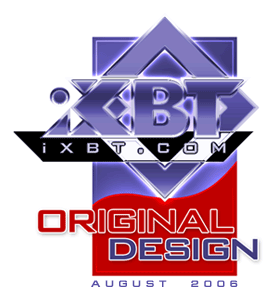 At the same time, if you scrutinize the diagrams, you will see that the performance differences between mobile 7K models from modern mobile 5K models are not that cardinal. The latter often demonstrate quite decent performance results, being nearly on a par, and sometimes even outperforming 7K models from Hitachi and Seagate! That is the rotational speed of 7200rpm in notebook drives is not a panacea and does not allow to raise HDD performance of mobile computers cardinally. A possible solution to this situation is forming simplest dual-drive RAIDs (0 and 1) rather than gradually increasing data density and transfer rates in mobile drives themselves. Modern Intel chipsets for notebooks with the Matrix RAID technology will help here. And notebook manufacturers (who actually try to launch RAID models) should provide enough room for a couple of hard drives inside mobile computers or allow users to add the second drive more often.
Write a comment below. No registration needed!
|
Platform · Video · Multimedia · Mobile · Other || About us & Privacy policy · Twitter · Facebook Copyright © Byrds Research & Publishing, Ltd., 1997–2011. All rights reserved. | |||||||||||||||||||||||||||||||||||||||||||||||||||||||||||||||||||||||||||||||||||||||||||||||||||||||||||||||||||||||||||||||||||||||||||||||||||||||||||||||||||||||||||||||||||||||||||||||||||||||||||||||||||||||||||||||||||||||||||||||||||||||||||||||||||||||||||||||||||||||||||||||||||||||||||||||||||||||||||||||||||||||||||||||||||||||||||||||||||||||||||||||||||||